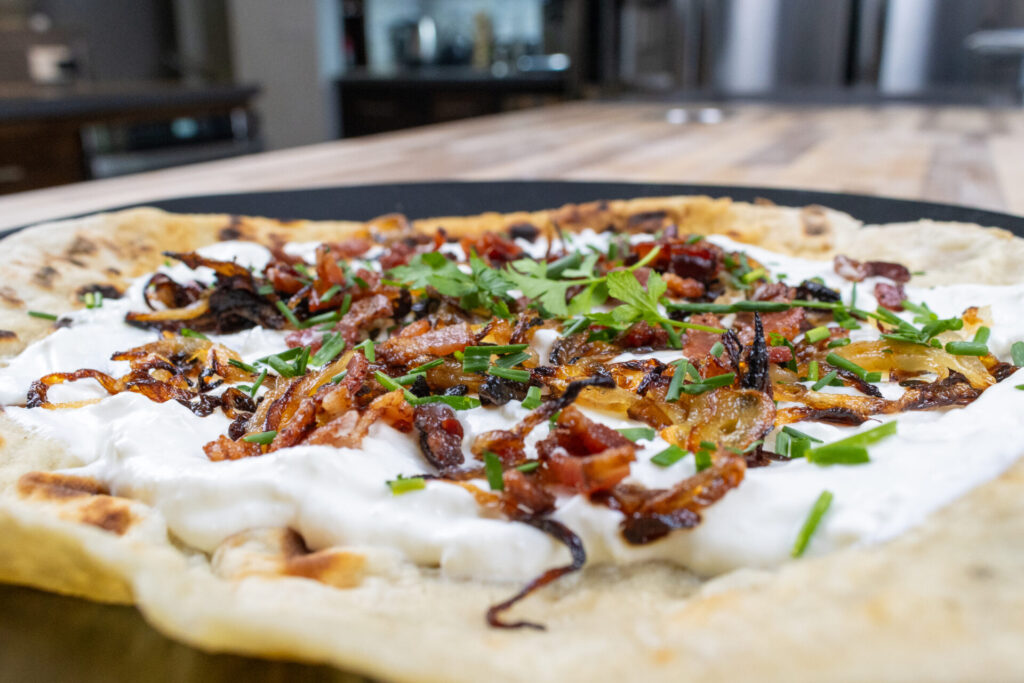* The amount of the potatoes includes skin and is approximate. Always use a little more potato than less. I prefer to use Russet potatoes, but other kinds of potatoes would work, too.
** Skip for a vegetarian option
Get ready for a culinary adventure straight from the heart of Slovakia and South Moravia! We're diving into the world of lokše, those irresistible potato flatbreads that are both versatile and oh-so-delicious. Whether you crave sweet with a dollop of plum preserves or savory with cheese and sauerkraut, lokše has...
Read more... got you covered. Today, we're putting a twist on tradition with a cheesy topping featuring feta – a tasty stand-in for the elusive Bryndza cheese. And to take it to the next level, we'll crown our lokše with a symphony of sautéed onions and bacon. Trust me, your taste buds are in for a treat! Note: sg. lokš, pl. lokše
Read less Tom the Chef Founder
Tom the Chef Founder
* The amount of the potatoes includes skin and is approximate. Always use a little more potato than less. I prefer to use Russet potatoes, but other kinds of potatoes would work, too.
** Skip for a vegetarian option
Let’s start preparing the lokše flatbread with bryndza cheese substitute and bacon.
Note: Cook potatoes with the peel on, and when fully cooked and cooled, you are going to peel them and then process them further.
Thoroughly rinse 2 LB of potatoes under cold water to remove surface dirt.
Place into a pot, add enough water to make sure that all potatoes are fully immersed, and then place them on a high-heat burner and cover with a lid.
Tips & Notes:
Tip:
You can speed up the process by immersing them in cold water.
½ cup of Extra Virgin Olive Oil
5 cloves of garlic – peeled
Process until smooth using an immersion blender.
Set aside for a later step.
1 LB of feta cheese – crumbled and drained
¾ cup of sour cream – adjust if needed
½ TSP of ground pepper
Process at high speed until combined and smooth (usually about 2 – 3 minutes).
Note:
Based on the consistency of the feta, some crumbles can be present even after extensive processing – it will not be a problem.
Leave it in a mixing bowl for later steps.
Notes:
2 sliced onions – sliced
Sauté with occasional stirring until the onions are glossy and slightly seared (usually about 3-4 minutes).
1 LB of bacon – diced
Sauté with constant stirring for about 3-4 minutes.
Tip:
If the bacon and onion cool down, briefly reheat them in the pan before serving.
Peel potatoes by hand or optionally use a paring knife for parts that are hard to peel. Dispose of the peel.
Tip:
For pieces that cannot be shredded– too small or falling apart – simply smash with your hand and add into the bowl.
2 ½ cups of all-purpose flour
¼ TSP of salt
Important:
Notes:
Place the dough on a floured surface and separate it into 6 even pieces using a dough cutter or knife (no need to be exact).
Then, using a rolling pin, roll each piece until you reach a circle with a diameter of about 12 inches or more if you have a large pan (the circle doesn’t need to be perfect).
Notes:
Preheat a non-stick frying pan over medium-high heat.
Tip:
The best way to transfer the formed lokše to the pan is to roll it onto the rolling pin and then unroll it onto the pan.
Cook until the side touching the pan is done – it will have a nice color with brown marks (usually about 1-3 minutes, but it can take less or more).
Then carefully turn using tongs.
While still in the pan, brush with the brushing mixture and cook until the other side is done.
When done, place the lokše on a plate and repeat with the remaining lokše – keep them piled to keep them warm.
Tips:
Spread about 1/6 of the cheese topping over the entire surface.
Sprinkle with about 1/6 of the sauteed bacon and 1/6 of the sauteed onion.
Finally, gently sprinkle with chives, salt, and pepper.
Serve opened or rolled, based on your preference.
All content and information (including recipes, articles, and other materials) on CookingHub.com are the opinions of the authors and are not intended to provide dietary, medical, legal, or political advice. Consult with a professional before deciding to follow these opinions.
Authors and www.CookingHub.com (operated by CookingHub Foundation) are not responsible for any part of any possible outcome or its consequences, which include (but are not limited to):
All readers (users and visitors of www.CookingHub.com) are responsible for evaluating the recipes and articles and making their own decisions about whether to follow the steps and recommendations. They must ensure that the ingredients and steps fit with their dietary restrictions and avoid preparation methods that could pose a health risk due to an unsuitable diet.
Share
Click on the icons below to share "Title of the item to share"